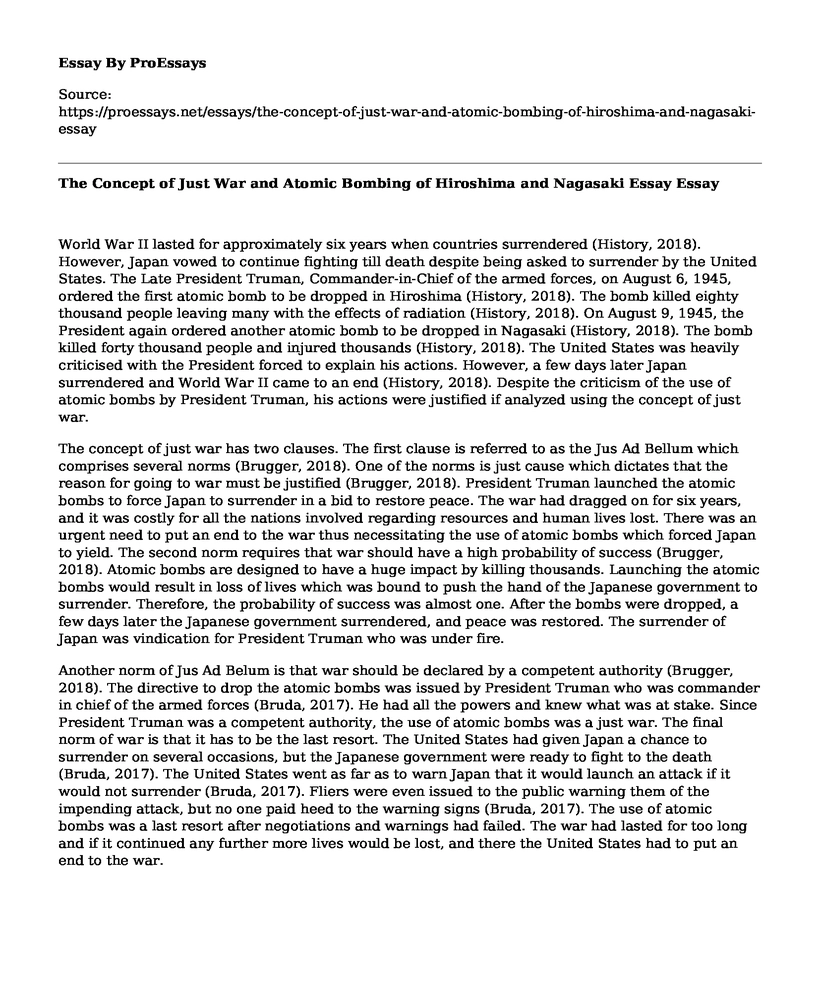World War II lasted for approximately six years when countries surrendered (History, 2018). However, Japan vowed to continue fighting till death despite being asked to surrender by the United States. The Late President Truman, Commander-in-Chief of the armed forces, on August 6, 1945, ordered the first atomic bomb to be dropped in Hiroshima (History, 2018). The bomb killed eighty thousand people leaving many with the effects of radiation (History, 2018). On August 9, 1945, the President again ordered another atomic bomb to be dropped in Nagasaki (History, 2018). The bomb killed forty thousand people and injured thousands (History, 2018). The United States was heavily criticised with the President forced to explain his actions. However, a few days later Japan surrendered and World War II came to an end (History, 2018). Despite the criticism of the use of atomic bombs by President Truman, his actions were justified if analyzed using the concept of just war.
The concept of just war has two clauses. The first clause is referred to as the Jus Ad Bellum which comprises several norms (Brugger, 2018). One of the norms is just cause which dictates that the reason for going to war must be justified (Brugger, 2018). President Truman launched the atomic bombs to force Japan to surrender in a bid to restore peace. The war had dragged on for six years, and it was costly for all the nations involved regarding resources and human lives lost. There was an urgent need to put an end to the war thus necessitating the use of atomic bombs which forced Japan to yield. The second norm requires that war should have a high probability of success (Brugger, 2018). Atomic bombs are designed to have a huge impact by killing thousands. Launching the atomic bombs would result in loss of lives which was bound to push the hand of the Japanese government to surrender. Therefore, the probability of success was almost one. After the bombs were dropped, a few days later the Japanese government surrendered, and peace was restored. The surrender of Japan was vindication for President Truman who was under fire.
Another norm of Jus Ad Belum is that war should be declared by a competent authority (Brugger, 2018). The directive to drop the atomic bombs was issued by President Truman who was commander in chief of the armed forces (Bruda, 2017). He had all the powers and knew what was at stake. Since President Truman was a competent authority, the use of atomic bombs was a just war. The final norm of war is that it has to be the last resort. The United States had given Japan a chance to surrender on several occasions, but the Japanese government were ready to fight to the death (Bruda, 2017). The United States went as far as to warn Japan that it would launch an attack if it would not surrender (Bruda, 2017). Fliers were even issued to the public warning them of the impending attack, but no one paid heed to the warning signs (Bruda, 2017). The use of atomic bombs was a last resort after negotiations and warnings had failed. The war had lasted for too long and if it continued any further more lives would be lost, and there the United States had to put an end to the war.
Conclusion
In conclusion, the launching of the atomic bombs upheld the norms of the concept of just war. The bombings were for a just cause of restoring peace, and they also had a high probability of success. The bombings were also declared by President Truman who was a competent authority. Finally, the war was a last resort after all other means had failed. By upholding the norms, the atomic bombs of Hiroshima and Nagasaki qualify as just war. In the end, peace was restored though at a cost.
References
Bruda, B. (2017, Dec 5). The Atomic Bombing of Hiroshima and Nagasaki & Just War Theory. Retrieved from https://medium.com/@bruder.melo/the-atomic-bombing-of-hiroshima-and-Nagasaki-just-war-theory-bb59b1e5ec41
Brugger, C. (2018, October 3). Just War and the Bombing of Hiroshima and Nagasaki. Retrieved from http://www.ncregister.com/blog/christianbrugger/just-war-and-the-bombing-of-Hiroshima-and-Nagasaki
History (2018, August 29). Bombing of Hiroshima and Nagasaki. Retrieved from https://www.history.com/topics/world-war-ii/bombing-of-hiroshima-and-nagasaki
Cite this page
The Concept of Just War and Atomic Bombing of Hiroshima and Nagasaki Essay. (2022, Nov 06). Retrieved from https://proessays.net/essays/the-concept-of-just-war-and-atomic-bombing-of-hiroshima-and-nagasaki-essay
If you are the original author of this essay and no longer wish to have it published on the ProEssays website, please click below to request its removal:
- The Lost Cause, the New South, the Agrarian Revolt Essay
- Prince Henry Essay Example
- Essay Sample on 20th Century US Expansion: Industry, Immigration, Urbanization
- Research Paper on The El Salvadoran Civil War: Historical Context and Events
- Research Paper on The Cold War: A Conflict That Almost Brought the World to Its Knees
- Ethnocentrism & Eugenics: 400BC to Present - Essay Sample
- Essay Sample on Invictus: Uniting a Nation Through Leadership and Equality







